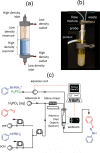In-Line Purification: A Key Component to Facilitate Drug Synthesis and Process Development in Medicinal Chemistry
- PMID: 31938456
- PMCID: PMC6956355
- DOI: 10.1021/acsmedchemlett.9b00491
In-Line Purification: A Key Component to Facilitate Drug Synthesis and Process Development in Medicinal Chemistry
Abstract
In-line purification is an important tool for flow chemistry. It enables effective handling of unstable intermediates and integration of multiple synthetic steps. The integrated flow synthesis is useful for drug synthesis and process development in medicinal chemistry. In this article, we overview current states of in-line purification methods. In particular, we focus on four common methods: scavenger column, distillation, nanofiltration, and extraction. Examples of their applications are provided.
Copyright © 2019 American Chemical Society.
Conflict of interest statement
The authors declare no competing financial interest.
Figures







References
-
- Newman S. G.; Jensen K. F. The role of flow in green chemistry and engineering. Green Chem. 2013, 15 (6), 1456–1472. 10.1039/c3gc40374b. - DOI
-
- Murray P. R.; Browne D. L.; Pastre J. C.; Butters C.; Guthrie D.; Ley S. V. Continuous flow-processing of organometallic reagents using an advanced peristaltic pumping system and the telescoped flow synthesis of (E/Z)-tamoxifen. Org. Process Res. Dev. 2013, 17 (9), 1192–1208. 10.1021/op4001548. - DOI
LinkOut - more resources
Full Text Sources
Other Literature Sources

